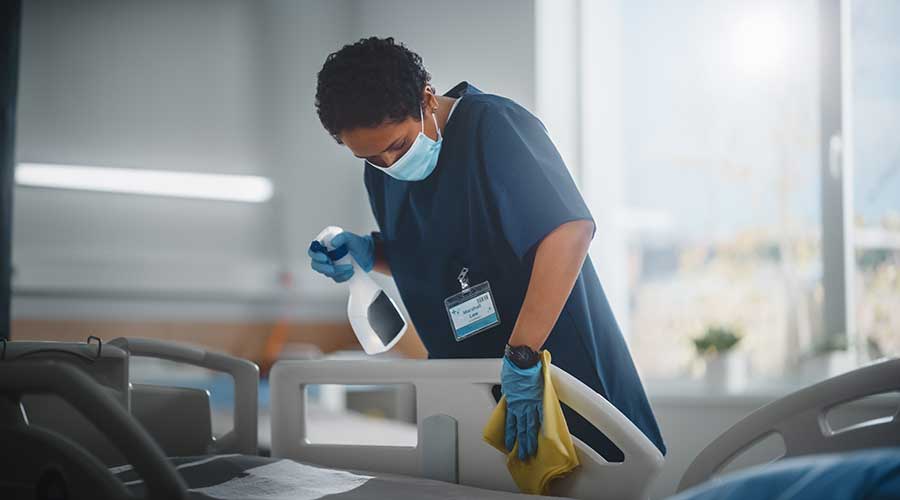I recently posted this question on LinkedIn: “What are your top one or two disinfecting practices?” The question received over 5,300 views and 39 replies from around the globe. Here are the best "to dos” from some of the brightest professionals I know:
“Follow a rigorous cleaning protocol with the right products. Use disinfectants approved by the U.S. Environmental Protection Agency (EPA). Ensure the disinfectants used are registered with the EPA and are appropriate for healthcare settings. Check the product label for the specific pathogens they target.
Adhere to manufacturer instructions. Carefully read and follow the instructions for the disinfectant, including the required contact time — the time the surface should remain wet — and dilution ratios. Incorrect use can reduce the effectiveness of the disinfectant.
Develop and implement a comprehensive cleaning schedule that addresses high-touch surfaces such as doorknobs, handrails, light switches and bedrails. Daily cleaning is essential to prevent the spread of infections.”
— C. Rosario, director of custodial services, Fairfield University
“Read the manufacturer's instructions for use on how to clean and disinfect the item. Sit on product evaluation committees to assess the way items should be cleaned, disinfected and stored.”
— Julie M. Richards, IPC specialist, Defense Health Agency
“Use UV-C disinfection, and validate disinfection results with accurate and precise dosimeters to make sure the process has achieved its targets.”
— Dane Rönnholm, sales director EMA, Intellego Technologies
“What if a visual real-time cue was available to confirm surface coverage and pressure when cleaning or disinfecting with ready-to-use wipes? And what if it could be used by anyone everywhere they clean without changing the wipes they currently use?”
— Trent Woodruff, consultant
“Understand that cleaning does not mean disinfection. Clean first, then disinfect. Organic material might inhibit the ability to disinfect.”
— Sandra Dunford, retired
“Follow the mattress company’s instructions for use.
When disinfecting a medical device and not following the manufacturer’s instructions for use, validate the alternate process. Short of that, a facility can be cited by regulators. In an outbreak, a plaintiff attorney could ask for the same documentation to validate the alternate process. For example, when it comes to a soft, porous mattress surface, the EPA disinfectant registration specifically says, ‘Intended only for non-porous mattresses.’ So the facility is a sitting duck in the courtroom.”
— Bruce Rippe, CEO, Trinity Guardion
“When wiping surfaces, apply 1-2 pounds of pressure to the wiper. Workers who do not use enough friction are just wetting a surface without removing the soil where the ‘bad guys’ hide.”
— Benjamin Kenyon, T-CSCT, T-CHEST, T-CNACC, CMIP
“Ensure all staff, not just environmental services, are aware and trained to use disinfectants correctly. Training and education are very important.”
— Madelaine Cuevas, BSN, MSN, CCRN, CIC, LTC-CIP
“Stress the critical importance of pre-cleaning a surface before disinfection and sanitizing. I have asked disinfectant and sanitizing sales reps, “What constitutes a ‘heavy/gross soil load’ on a surface?” statement on your label? Their answers sound like a politician that continually refuses to answer the question.”
-- Mike Zanche, director of operations and product development, Gabriel First Corp.
“Take the time to observe your staff to witness their practice vs what is in your policy vs best practice.
Meet with all department heads and front-line workers to determine best use of resources (e.g. FTEs) to create a written matrix of who will be responsible for which cleaning/disinfecting tasks”
— Carlos Mendoza, MPH, CIC, LTC CIP, CFPM
“Ensure that all who are responsible for room or procedure turn over have competencies.”
— Carol Calabrese, RN, BS, T-CSCT, CHESP, CIC
J. Darrel Hicks, BA, MESRE, CHESP, Certificate of Mastery in Infection Prevention, is the past president of the Healthcare Surfaces Institute. Hicks is nationally recognized as a subject matter expert in infection prevention and control as it relates to cleaning. He is the owner and principal of Safe, Clean and Disinfected. His enterprise specializes in B2B consulting, webinar presentations, seminars and facility consulting services related to cleaning and disinfection. He can be reached at darrel@darrelhicks.com, or learn more at www.darrelhicks.com.

 Building Sustainable Healthcare for an Aging Population
Building Sustainable Healthcare for an Aging Population Froedtert ThedaCare Announces Opening of ThedaCare Medical Center-Oshkosh
Froedtert ThedaCare Announces Opening of ThedaCare Medical Center-Oshkosh Touchmark Acquires The Hacienda at Georgetown Senior Living Facility
Touchmark Acquires The Hacienda at Georgetown Senior Living Facility Contaminants Under Foot: A Closer Look at Patient Room Floors
Contaminants Under Foot: A Closer Look at Patient Room Floors Power Outages Largely Driven by Extreme Weather Events
Power Outages Largely Driven by Extreme Weather Events